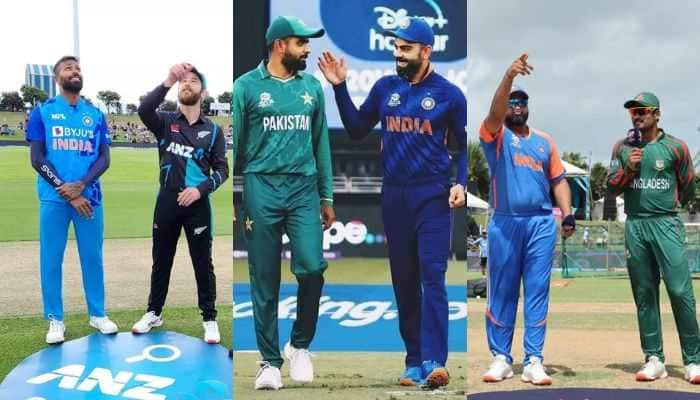Karnataka exit polls: What CVoter data reveals and how BJP, Congress and JDS got the votes
The CVoter exit poll has predicted that the Bharatiya Janata Party is likely to secure a majority in the 224-member Karnataka Assembly.
Trending Photos
)
Karnataka Assembly election results will be declared on May 15 and all the parties and candidates are waiting with bated breath to find out fate. On May 12 after the voting, several exit polls came out with their likely results.
The CVoter exit poll has predicted that the Bharatiya Janata Party (BJP) is likely to secure a majority in the 224-member Karnataka Assembly. According to CVoter data, BJP will win 104-116 seats while the Congress will end with 83-94 MLAs. Former prime minister HD Deve Gowda's Janata Dal Secular is expected to bag 20-29 seats while other smaller parties and independents may win 0-7 seats.
Yashwant Deshmukh, the managing director and chief editor of Centre for Voting Opinion & Trends in Election Research (CVoter), the Karnataka Assembly elections 2018 gave a breakdown of how his company conducted the exit poll and the voting preferences of different castes, communities and groups.
In a series of tweets on Sunday, Deshmukh released the data collected by CVoter on Karnataka Assembly elections and the exit poll. "Here are the demographic trends from #Karnataka. We are posting all trends from raw unweighted file of @CvoterIndia . They give critical information on how different sections of Kannadiga Society have voted yesterday. There are some confirmations on old equations, some new ones," reads his first tweet on the Karnataka exit poll data.
Here are the demographic trends from #Karnataka . We are posting all trends from raw unweighted file of @CvoterIndia . They give critical information on how different sections of Kannadiga Society have voted yesterday. There are some confirmations on old equations, some new ones.
— Yashwant Deshmukh (@YRDeshmukh) May 13, 2018
According to him most of the voters from the Scheduled Caste and minority communities have gone with the Congress. Among the Other Backwards Castes there has been a split between the Congress and BJP while a majority of Lingayat voters have preferred the latter. Vokkaliga's put their faith in JDS while there is a split in the Scheduled Tribe voters too.
"Lets start with the age old Religion/Caste matrix. As expected the SC and Minorities have gone for Congress, OBC a split and Lingayat votes have gone for BJP. The JDS takes majority of Vokkaliga; one way in South though. The surprise pack: ST votes," he tweeted.
Here are the demographic trends from #Karnataka . We are posting all trends from raw unweighted file of @CvoterIndia . They give critical information on how different sections of Kannadiga Society have voted yesterday. There are some confirmations on old equations, some new ones. — Yashwant Deshmukh (@YRDeshmukh) May 13, 2018
"The Gender equation is interesting. More females have opted for BJP than the Congress. This is in trend with other states in recent years; but in Karnataka this is a first. Male voters are a virtual split," he claimed.
Lets start with the age old Religion/Caste matrix. As expected the SC and Minorities have gone for Congress, OBC a split and Lingayat votes have gone for BJP. The JDS takes majority of Vokkaliga; one way in South though. The surprise pack: ST votes. pic.twitter.com/usvs9IlE1g — Yashwant Deshmukh (@YRDeshmukh) May 13, 2018
But according to him, caste and religion may not give enough insight into how the voting took place. "The real story of Karnataka might not be in Caste/Religion though. They are on expected lines. But the Age matrix of Karnataka is a matter of detailed analysis. The first time voters and youngsters have tilted the scales for BJP. But as the Age bar goes up; Congress scores," he said.
The real story of Karnataka might not be in Caste/Religion though. They are on expected lines. But the Age matrix of Karnataka is a matter of detailed analysis. The first time voters and youngsters have tilted the scales for BJP. But as the Age bar goes up; Congress scores. pic.twitter.com/1aO28PAyMS — Yashwant Deshmukh (@YRDeshmukh) May 13, 2018
"The income group distribution is on expected lines. The low income and disadvantaged groups has supported Congress in big numbers. As the Income bar goes up; so does the support for the BJP. So does the critical Middle Class. If in a low income State; Congress would be home," the tweet reads.
The income group distribution is on expected lines. The low income and disadvantaged groups has supported Congress in big numbers. As the Income bar goes up; so does the support for the BJP. So does the critical Middle Class. If in a low income State; Congress would be home. pic.twitter.com/n1JzrO4RnB — Yashwant Deshmukh (@YRDeshmukh) May 13, 2018
His tweets also claim: "The Education equation is working more or less on the traditional age old lines. Lower the education; more the support for Congress. Higher the education levels, more the support for the BJP. Middle levels of education are virtually split among the two."
The Education equation is working more or less on the traditional age old lines. Lower the education; more the support for Congress. Higher the education levels, more the support for the BJP. Middle levels of education are virtually split among the two. pic.twitter.com/CZi4j4iPsE — Yashwant Deshmukh (@YRDeshmukh) May 13, 2018
"Last but not the least, the Occupation matrix reconfirms old equations, but also throws up few surprises. The Agriculture sector; Farmers as well as farm-laborers, are supporting Congress. Self-employed and Service class for BJP. But the surprise pack?? Housewives & Unemployed," he added.
Last but not the least, the Occupation matrix reconfirms old equations, but also throws up few surprises. The Agriculture sector; Farmers as well as farm-laborers, are supporting Congress. Self-employed and Service class for BJP. But the surprise pack?? Housewives & Unemployed. pic.twitter.com/tu6KPwsYz5 — Yashwant Deshmukh (@YRDeshmukh) May 13, 2018
While the final Karnataka Assembly election results will be known only by the afternoon of May 15, the above data gives a crucial insight into the voting pattern in the state. All the three major parties - Congress, BJP and JDS - have been claiming they will win and form the government after results are declared. But the voters have given their verdict and once the EVMs are opened their preference will become clear.
Stay informed on all the latest news, real-time breaking news updates, and follow all the important headlines in india news and world News on Zee News.
Live Tv







)
)
)
)
)
)
)
)
)
)
